U.S. President Donald Trump and Russian President Vladimir Putin concluded their highly anticipated summit in Anchorage, Alaska, with no formal agreement reached, even as Trump hailed their first in-person talks since 2019 as “very productive.”
The nearly three-hour encounter, held at a U.S. Air Force base, ended without a ceasefire deal for Ukraine. At a brief joint press appearance, both leaders offered no specifics, declined questions from the press, and made only guarded statements. Trump insisted the meeting cleared the path for future negotiations, including a potential trilateral summit with Ukrainian President Volodymyr Zelenskiy, though no firm arrangements were announced.
Trump said progress had been made on several fronts, but acknowledged that sticking points, among them inaccessible “significant” issues remain unresolved. “We’ve made some headway… there’s no deal until there’s a deal,” he stated, adopting a notably cautious tone.
Putin, likewise, praised the summit’s tone while insisting Russia’s preconditions remain crucial. He emphasized the necessity of addressing what Moscow views as the “root causes” of the conflict and asked that Ukraine and its allies not jeopardize any emerging consensus.
The summit featured symbolic visuals throughout a red carpet, shared banter, and even Trump greeting Putin with warm gestures. But despite the optics, the outcome was largely seen as muted: no ceasefire, no detailed roadmap, just diplomatic theatre.
In the aftermath, Trump reached out to Ukrainian officials, placing calls to President Zelenskiy and NATO leaders to update them on the talks. Zelenskiy reaffirmed Ukraine’s willingness to engage but insisted that any advancement must protect sovereignty and reject forced territorial concessions.
Critics were quick to dismiss the summit as largely symbolic. Analysts and NATO officials warned that Putin emerged politically advantaged while the conflict on the ground in Ukraine continued unabated.





